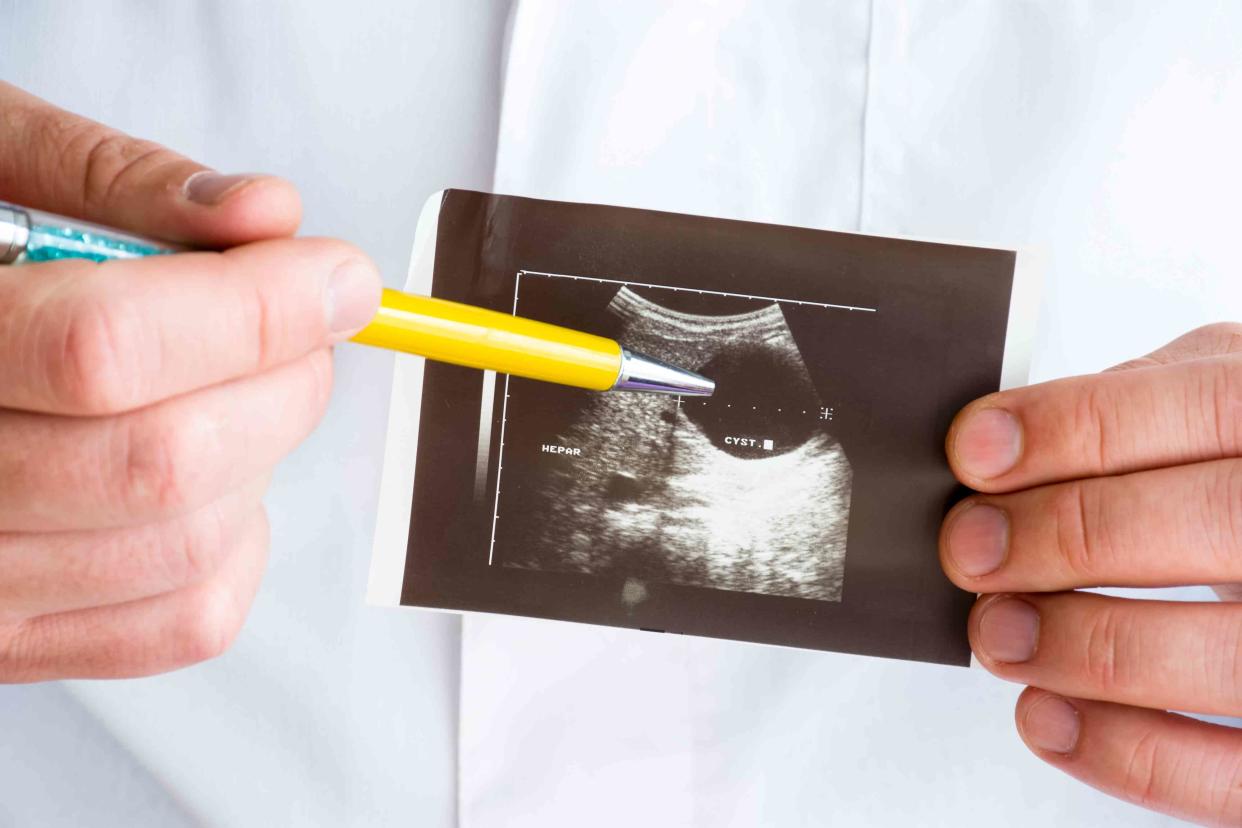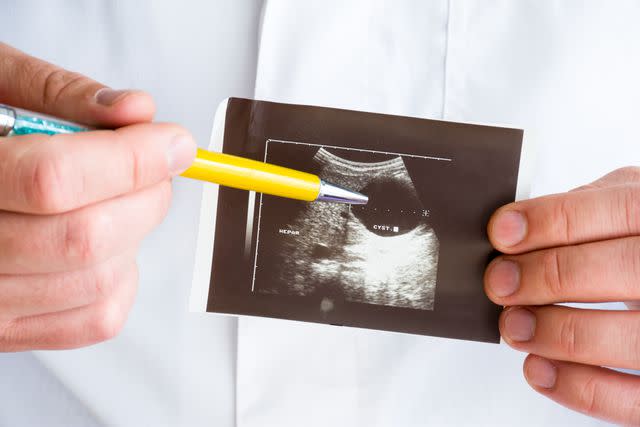When Do Liver Cysts Cause Complications?

Shidlovski / Getty Images
Medically reviewed by Robert Burakoff, MD, MPH
Liver cysts, also called hepatic cysts, are fluid-filled sacs that form in your liver. They can develop before birth or later in life. The problem affects from 5% to 10% of people.
It is rare for liver cysts to cause liver cancer or liver failure. Only about 10% to 15% of people with liver cysts have symptoms. Symptoms usually occur in large liver cysts that grow big enough to cause pain or affect liver function.
Treatment of large cysts can involve drainage, surgery, or drugs. Therapy for liver cysts is usually effective and free of complications.
This article describes liver cyst causes, symptoms, and treatment. It also discusses when the problem becomes a serious issue.

Shidlovski / Getty Images
Causes: Why Do Liver Cysts Form?
Causes of liver cysts can be congenital (formed before birth) or acquired. The most common known causes of liver cysts include the following:
Congenital (form before birth): Most benign (noncancerous) and harmless liver cysts form before you are born. Research indicates that these liver cysts likely form due to a defect in your bile ducts (the tubes attached to your liver that help with your digestive process.)
Genetic disease: Certain genetic (inherited) disorders like polycystic liver disease (PLD) and polycystic kidney disease (PKD) promote the development of multiple liver cysts that grow and multiply.
Parasitic infection: Infection with the Echinococcus tapeworm, found in sheep in different parts of the world, can cause liver cysts. Infection usually occurs after exposure to this parasite from water or infested vegetables that contain feces from an infected animal.
Polycystic Liver Disease
PLD is a rare genetic disease in which multiple cysts develop on your liver and continue to grow. This condition is usually present at birth, though large cysts typically don't occur until adulthood. Symptoms such as pain can occur as these cysts become larger.
Size of Liver Cyst and Potential Complications
Cyst size rises with age. As cysts increase in size, they have a higher risk of causing symptoms such as bloating and pain in the upper right portion of your abdomen. This can increase your risk of symptoms.
Complications caused by liver cysts are uncommon. Rarely, liver cysts have complications of liver failure and liver cancer. Other rare complications include the following serious conditions:
Hemorrhagic rupture (a burst cyst that releases blood and fluid)
Torsion (twisting)
Biliary fistula (ulcers that connect the organs and ducts that make and store bile with other organs)
Obstructive jaundice (a narrow or obstructed bile duct that causes a buildup of bilirubin)
Portal vein (main blood vessel to the liver) blockage
Portal vein hypertension (increased pressure)
Budd-Chiari syndrome (blockage of the veins that drain your liver)
Liver Cyst Symptoms
Most liver cysts do not cause symptoms. They are usually found during an abdominal ultrasound or computed tomography (CT) scan for other reasons.
When symptoms occur, it is usually due to increasing size, which can lead to mechanical compression, rupture, hemorrhage into the cyst, or infection. These factors cause the following symptoms:
Abdominal pain
Abdominal fullness
Nausea and vomiting
Early satiety (feeling full shortly after eating a small amount of food)
Back pain
Dyspnea (difficult or labored breathing)
Cough
Palpable mass (able to be touched or felt) on physician examination
In rare cases, symptoms can also include the onset of sudden and severe right upper quadrant and shoulder pain.
Learn More: Causes of Abdominal Swelling and Bloating
Types of Liver Cysts
There are two types of liver cysts. They are usually differentiated based on the following characteristics:
Simple cysts:
The most common form of liver cysts
Can be congenital (more often in females age 40–70 years) and acquired (more often in males age 30–50 years)
Thin, smooth walls which secrete bile-like fluid
Range in size from less than 1 centimeters (cm) up to 30 cm in diameter, though most are less than 3 cm in size
Complex cysts:
Include inflammatory, infectious, post-traumatic, and other miscellaneous causes
Include separations, thickening and/or nodules, debris-containing fluid, and hemorrhagic or proteinaceous contents
First-Line Treatment for Liver Cyst
First-line treatment for a liver cyst involves fenestration, or "de-roofing," which is regarded as the standard treatment, according to American College of Gastroenterology guidelines. This involves the electrosurgical removal of the dermis ("roof") of a cyst and then draining it.
Since the cyst sac is left in place, this procedure usually is not a permanent solution. As a result, your surgeon may use a sclerosing agent (an injection to help fluid from accumulating in the cyst sac).
De-roofing is performed using one of the following procedures:
Laparoscopic surgery: Accessing the inside of the abdomen using a long, narrow tube with a light and camera on the end inserted into the abdomen through small incisions
Open surgery: Cutting the skin and tissues so the surgeon has a full view of the organs or structures involved
Liver cysts that are infected by the echinococcus parasite are treated with prescription medication along with drainage or removal of the cyst. The most effective treatment involves a combination of oral Albenza (albendazole) with or without Biltricide (praziquantel) or chemotherapy with a benzimidazole.
Learn More: How Liver Cysts Are Treated
How to Relieve Liver Cyst Symptoms
There are no over-the-counter medications or home remedies proven to remove or reduce liver cyst symptoms. Your healthcare provider can recommend pain relievers that can help relieve discomfort until you receive appropriate treatment.
Your healthcare provider also can help you determine whether dietary changes will reduce your symptoms. Common general food tips for a healthy liver include the following:
Avoid foods high in fat, sugar, and salt.
Avoid fried foods and fast foods.
Don't eat raw or undercooked shellfish.
Avoid or limit alcohol as advised.
Eat a balanced diet from all food groups.
Eat food with fiber (fruits, vegetables, whole grain braids, rice, and cereals)
Drink plenty of water.
PCOS and Polycystic Liver Disease
Nonalcoholic fatty liver disease (NAFLD), a condition in which more than 5% to 10% of your liver's weight is fat, affects up to 55% of women with polycystic ovary syndrome (PCOS). NAFLD can cause fatty liver cysts.
The first line of treatment for NAFLD is weight loss through a combination of weight reduction, exercise, and eating a healthy, balanced diet to reduce fat, inflammation, and scarring in the liver.
Treatment for Complicated Liver Cyst
Treatment for a complicated liver cyst involves one of the following procedures:
Hepatectomy (hepatic resection or complete cyst excision): The surgical removal of all or a portion of a liver damaged by cysts or other diseases
After a full hepatectomy: The replacement of a removed liver with a healthy liver from a deceased donor's body
After a partial hepatectomy: The replacement of an excised liver section with a portion of a healthy liver from a living donor
Learn More: Top 6 Single-Organ Transplants
Risks of Liver Cyst Surgery
The risks of liver cyst surgery are relatively low. The majority of people who have this procedure achieve symptomatic relief with a low recurrence rate of 9.6% and a rate of 7.1% for re-intervention for the same cyst.
Though complications of liver cyst surgery are rare, the most common risks involve the following:
Infection at the site of one of the small incision sites
Decrease in liver function
Abdominal bleeding
Leakage of bile into your abdomen
Ascites (a collection of fluid in the spaces within the abdomen)
Injury to an adjacent organ such as your spleen, small intestine, or pancreas
Pleural effusion (buildup of fluid around your lung)
Dyspnea (difficult or labored breathing)
Postoperative ileus (interruption of normal function of your intestines due to a blockage that lasts for several days after surgery)
Serious Postsurgical Symptoms of Liver Cyst Surgery
The following symptoms may be a sign of serious complications after liver cyst surgery. Contact your surgeon if you have any of the following symptoms after liver cyst surgery:
Severe pain
Persistent high fever (over 101 degrees F)
Chills
Persistent shortness of breath or coughing
Rectal bleeding
Nausea or vomiting
Odor from your incision
An incision that has increased drainage of pus
Increased redness around any incision
Jaundice (yellowing of your skin and the whites of your eyes)
Inability to eat or drink
Summary
Liver cysts can exist at birth or they can happen later in life. They are often harmless and asymptomatic. Most people learn that they have this problem during imaging tests for other reasons.
Liver cysts are typically benign and rarely cause symptoms that hinder your quality of life. Even when they are found, you may be advised to not start treatment until symptoms occur.
Symptoms can appear as liver cysts age and increase in size. Though the most common symptoms are not unique to this disease, getting an accurate diagnosis can help you resolve the problem. Current treatment options are viewed as safe and effective.

